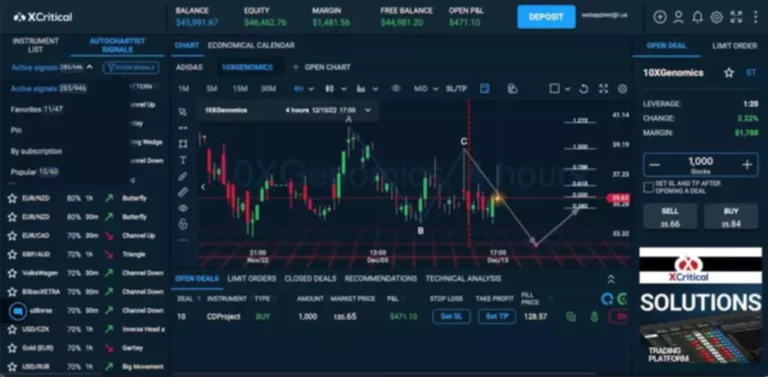Content
In other words, it does not matter who starts the conversation, only that it takes place and that it happens on an ongoing basis. Once this kind of dialogue gets underway, asset managers will stand a better chance of optimising their liquidity outcomes and getting the best results possible. The sell side can start the conversation by asking buy-side firms what matters to them and what their pain points are. Or, the buy-side https://www.xcritical.com/ can initiate the discussion by highlighting any concerns they have.
How To Utilize ICT Concepts In TrendSpider
They may come to us with a concern based on recent results, but not have the broader data to investigate and try to understand what’s leading to the outcomes they are seeing. But if Stablecoin they share their thoughts, we can determine if an issue is unique to them or more widespread. Retail traders use ICT to look for imbalances in the market, investigate smart money’s trading behaviour patterns and profit from large price swings. ICT is a technique that analyses the inner workings of the financial markets, specifically in Forex and crypto trading. This approach was created by Michael J. Huddleston, an industry veteran with over 25 years of experience.

Market Turmoil and Central Banks
They strategically leverage the collected buy orders at these highs to drive prices upward. They create good conditions for buying and selling assets, making the most of price changes to get more money. These include stop losses, retail investors, price changes, what is buy side liquidity and the main roles of buyers and sellers in the market. In fast and volatile markets, quick position closures by traders lead to price reversals in the opposite direction. It’s crucial to note that buy-side liquidity refers to a certain level on the chart. With bilateral liquidity to the buy side in its nascent stage, it remains to be seen how access will evolve.
Understanding the Relationship Between Liquidity and Market Movement
Tamta is a content writer based in Georgia with five years of experience covering global financial and crypto markets for news outlets, blockchain companies, and crypto businesses. With a background in higher education and a personal interest in crypto investing, she specializes in breaking down complex concepts into easy-to-understand information for new crypto investors. Tamta’s writing is both professional and relatable, ensuring her readers gain valuable insight and knowledge.
The intersection of buy side trading and liquidity provision is a dynamic that beckons skilled traders to attune their strategies accordingly. The indicator will provide you with two hidden plots to mark the next Buyside or Sellside liquidity levels to use in your automated trading strategy. Meanwhile, during this period, industry experts say that Optiver is leading the recent growth in offering bilateral liquidity directly to the buy side. The trend of trading directly with market makers began in the ETF market and single stock options desks through a request-for-quote (RFQ) mechanism.
- Always do your own careful due diligence and research before making any trading decisions.
- The Current Ratio is a critical liquidity ratio that signals a company’s short-term liquidity health.
- Price can move up when the ceiling above it is broken, and it can move down when the floor below is broken.
- The reduction in supply entering the market has tempered the impact of the recent correction.
- Liquidity’s role in price action is multifaceted, impacting both stability and responsiveness within Forex markets.
- Central banks, like India’s RBI, use various methods to ensure sufficient money availability, particularly during times of crisis.
Traders can also use other technical indicators, such as trend lines and moving averages, to confirm potential reversal points further. Testimonials appearing on this website may not be representative of other clients or customers and is not a guarantee of future performance or success. Imagine for a minute that the market is a hi-rise building – but one without stairs. Price can move up when the ceiling above it is broken, and it can move down when the floor below is broken. This is in the form of limit orders, and this is what we refer to when we talk of “liquidity”.
To utilize this tool, simply click on the ‘Auto Fib’ button in your top toolbar and a Fibonacci sequence will be drawn on the most recently completed move per the time frame selected. Balanced Price Ranges can sometimes signal the beginning of a Market Structure Shift, and the price can often retest and reject from these areas. This article will delve into these concepts and explore how they can be applied in trading.
For many traders, you can click by their name to see the trades along with the SIM/Live designation. If this is your first introduction to liquidity consumption concepts, just think about floors & ceilings. We can only move up by breaking through the ceiling and down by breaking through the floor.

Having a no-silo policy does not mean there are no specialisms – it just means that the different members of those specialist teams can work effectively together. Not every asset manager wants to adopt this approach at all times, and for some this hybrid strategy is used on an order by order basis. Recognising that liquidity can come from a wide variety of sources, buy-side firms that are going down this route are keen to ensure they use every tool in their arsenal. So, they will mix electronic trading, programme trading and high touch including the event driven desk to tap into the most optimal combination of liquidity sources. The ‘Gap Factor’ value will determine the size of the Fair Value Gap and it is preset to a value of ‘1’. In order for the indicator to highlight smaller Fair Value Gaps, simply utilize a decimal value.
This led to the creation of ELP/SIs providing streaming quotes via algorithms to the buy side through the broker smart order routers. The Cash Ratio is the most conservative liquidity ratio, considering only cash and cash equivalents against current liabilities. This ratio offers insights into a company’s ability to meet its obligations using only readily available cash, which is particularly relevant during financial downturns.
They provide bid and ask prices, act as counterparties, manage risk, improve price discovery, and provide efficiency. Without market makers, financial markets would be less liquid and less efficient. Therefore, it is crucial to have well-functioning market makers in financial markets. Identifying these Forex entry points can give traders an edge, allowing them to align with the upward movement anticipated by the collective market sentiment and the strategies of institutional traders.
On the flip side, if you’re looking to sell a portfolio company with a robust cash ratio and strong cash flow generation, potential buyers may perceive the company as financially resilient. This could lead to more lucrative offers and smoother negotiations, culminating in a more favorabledeal outcome. The Operating Cash Flow Ratio juxtaposes a company’s operating cash flow against its current liabilities. This ratio reveals the company’s ability to meet its short-term obligations from its core operations, indicating its financial health and operational efficiency. The Quick Ratio offers a more stringent measure of liquidity, focusing solely on the most liquid current assets and excluding inventory. This ratio provides a snapshot of a company’s immediate liquidity posture, highlighting its capacity to meet short-term obligations without relying on inventory liquidation or customer payments.

Institutions often accumulate orders at critical price points, thereby manipulating the currency’s supply and demand and driving market prices. Their activity can lead to price slippage and impact the overall flow of the Forex markets, both on the buy and sell side. However, Clarke predicts that bilateral liquidity in European equities will follow the precedent that already exists in foreign exchange, block ETFs and US equities. In European equities, he expects the EMSs will consolidate streaming quotes from multiple ELPs and potentially expand to include several of the major bank’s central risk books. Large financial institutions commonly manipulate this liquidity by absorbing or deploying strategic trades, impacting the overall market direction.
In doing so, they also place their stops higher than the resistance level to limit potential losses. However, if the price breaks through the resistance, all the stops that have been placed above it will be triggered. You can pair them with key levels such as Fair Value Gaps (FVG) or Order Blocks (OB) to create a simple trading strategy. This is considered a sweep of liquidity and you should now have a bullish bias in the market or look for long trade opportunities.